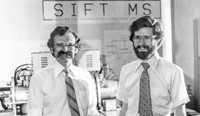Advertisement
Grab your lab coat. Let's get started
Welcome!
Welcome!
Create an account below to get 6 C&EN articles per month, receive newsletters and more - all free.
It seems this is your first time logging in online. Please enter the following information to continue.
As an ACS member you automatically get access to this site. All we need is few more details to create your reading experience.
Not you? Sign in with a different account.
Not you? Sign in with a different account.
ERROR 1
ERROR 1
ERROR 2
ERROR 2
ERROR 2
ERROR 2
ERROR 2
Password and Confirm password must match.
If you have an ACS member number, please enter it here so we can link this account to your membership. (optional)
ERROR 2
ACS values your privacy. By submitting your information, you are gaining access to C&EN and subscribing to our weekly newsletter. We use the information you provide to make your reading experience better, and we will never sell your data to third party members.
Mass Spectrometry
Expanding the repertoire of ion traps
Researchers are simultaneously shrinking mass specs and broadening their tandem capabilities
by Celia Henry Arnaud
May 28, 2018
| A version of this story appeared in
Volume 96, Issue 22
Something has been missing from ion traps, according to R. Graham Cooks, a chemistry professor at Purdue University who’s been developing the devices for more than two decades. Typically these mass analyzers capture ions with various voltages and frequencies applied across their electrodes. And typically, they can do only one type of tandem mass spec (MS/MS) experiment—a two-stage experiment that improves the ability of the instrument to identify components of complex mixtures.
COVER STORY
Expanding the repertoire of ion traps
For instance, until recently, if scientists wanted to use an ion trap to run an MS/MS experiment, virtually the only one available was a so-called product ion scan. In this experiment, you apply a voltage to the trap to confine a particular “precursor” ion. After that precursor is fragmented, the resulting ion bits are analyzed during a second scan.
Other mass analyzers, such as the triple quadrupole, have a broader repertoire of MS/MS scans, including the precursor ion scan, which identifies all precursors that produce a particular fragment ion, and the neutral-loss scan, which looks for fragments that have lost a particular neutral functional group. People thought those scans were too complicated for ion traps.
Cooks and his team, including graduate student Dalton T. Snyder, have shown that those scans can indeed be performed on quadrupole ion traps, including miniature ones (J. Am. Soc. Mass Spectrom. 2018, DOI: 10.1007/s13361-018-1922-1).
“There is now a series of scan methods that have been described out of this lab, which parallel all the experiments you can do with a triple quad and then some others that you can’t do with a triple quad,” Cooks says.
To achieve scans such as precursor ion and neutral-loss scans, Cooks’s group doesn’t need to scan the radio-frequency voltage that’s used to trap ions. Scanning the amplitude of the RF voltage is usually the way to record mass spectra with ion traps.
For the new scans, the researchers instead keep the amplitude fixed. And they apply various excitation frequencies to the electrodes that make up the trap.
“Once you’ve got the voltage fixed, you can play ‘notes’ on the resonant frequencies of the ions, and you can excite them and eject them in different directions,” Cooks says.
The mass analyzer itself is unchanged, Snyder explains. The difference is the scientists now apply resonant frequencies to the ions in directions other than toward the detector, the scheme that’s typically used.
“People thought the orthogonal direction, where there is no detector, was useless,” Snyder says. “But you can do all sorts of things in the orthogonal dimension. You can do scans we thought were possible only on a triple quad.”




Join the conversation
Contact the reporter
Submit a Letter to the Editor for publication
Engage with us on Twitter